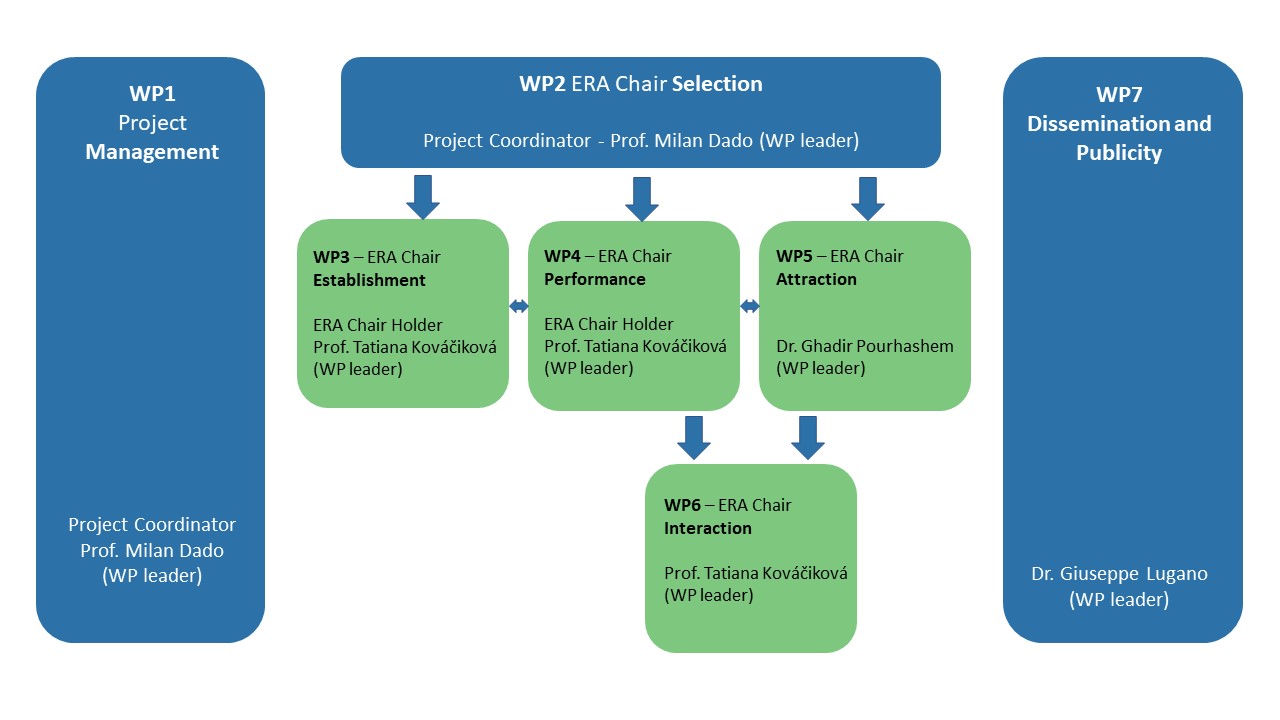ERAdiate began in July 2014 and runs until July 2019. The project is implemented through 7 work packages, the inter-relations of which can be seen in the figure below.

- Management (WP1)
This work package aims at ensuring that the project is appropriately managed as per the project plan, within budget and scheduled timescales. Tasks includes risk management, monitoring project progress, tracking deliverables and reporting back to the EC. WP1 will also control the quality of the performance, developments, achievement of milestones and deliverables.
- ERA Chair Selection (WP2)
In this work package, the selection procedure for the position of ERA Chair Holder will be prepared and conducted. Specific tasks include advertising the job vacancy, nominating the independent selection committee members, defining the selection criteria, and coordinating the ERA Chair selection process in accordance with the ERA priorities. WP2 is the strategic milestone for the implementation of the whole project.
- ERA Chair Establishment (WP3)
The overall objective of this WP is to create a stimulating, attractive, and competitive environment stimulating research, development and innovation with a high added value. This includes a complex analysis of the current state-of-the-art in the ITS research and innovation at UNIZA and the definition of a strategy for future sustainable development of research and innovative activities. Consecutive tasks include setting up the ERA Chair team structure and selecting the team members. This WP addresses the wider integration of research activities at regional and international level including industrial partnerships.
- ERA Chair Performance (WP4)
This WP contributes to the promotion of UNIZA activities and excellence in ITS research through the development of existing resources (human, infrastructure, contact database) and the organisation of workshops and conferences. More specifically, the WP intends to
- define strategies pertaining to the development of human resources and research teams in the ITS field at UNIZA
- develop the research infrastructure, notably define strategic research areas
- define education policies, especially in doctoral studies
- enhance networking and cooperation through the expansion of an international contact database and establishment of strategic partnerships with key players in Europe
- ERA Chair Attraction (WP5)
WP5 is oriented towards the effective widening of the participation of UNIZA in H2020 and other important European competitive programmes and towards the concentration of resources for funding research and innovations. This WP aims at enhancing UNIZA competences and competitiveness for grants through effective management of research and innovations. This includes activities such as the preparation of project proposals directed to the Horizon 2020 challenges and other important EU programmes for regional development, cross border collaboration, and the implementation of results for smart specialization as well as the management/coordination of supporting activities.
- ERA Chair Interaction (WP6)
WP6 is focusing on the interaction between UNIZA, regional and national authorities, as well as external stakeholders in the field of ITS research, development, innovative implementation and operation. Such interaction aims to achieve the positive spill-over effects of implementing the ERAdiate project, to initiate and support structural changes and to intensify the cooperation with regional, national and cross-border authorities and bodies with a view to enhance the research excellence and the innovation chain.
- Dissemination and Publicity (WP7)
The objective of the dissemination and publicity work package is to raise awareness about the developments and outcomes of the project and to disseminate information about the project, its objectives and results. Within this work package, strategy and policies will be established in order to effectively spread excellence and ensure that the project objectives, results and knowledge gained within the project are widely promoted to the target groups at national and European level. All key stakeholders such as public administrations, academics, relevant enterprises and research institutions are involved, in order to foster the impact of the project activities and results.
